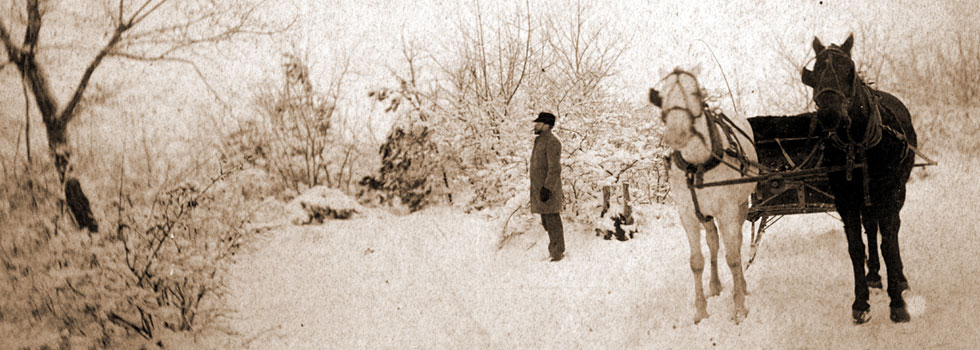A tanner turns animal hides such as ox, cow, bull, and horse and skins like calf, sheep, pig and deer into leather. Hides and skins were procured from local farmers.
The process began with cutting the hides into workable pieces called “sides” and trimming off the ragged edges. The sides were then soaked in water to soften the hide and to loosen the hair. The sides were re-soaked in lime-water or stacked wet for a few days in a technique called “sweating” to further loosen the hair.
The hides were taken from the water or sweating stack and placed on a “slanting beam.” Using a two handle knife, the tanner scraped the fat and tissue off the flesh side and the hair and outer layer of the skin or the epidermis on the grain side.

Tanner’s Beam, “In the case of limed stock the hides, at the proper stage, are withdrawn from the pits and stretched over an unhairing beam.” —The Encyclopedia Britannica, 1910. Source: The Encyclopedia Britannica, New Warner Edition (New York, NY: The Werner Company, 1893), etc.usf.edu
After the scraping, the fibrous under-skin or corium was left. Permeated with gelatin, it needed a meticulous cleaning.

“Another machine now largely used by curriers is the scouring machine, a level table or platform freely movable in all directions, having mounted over it a reciprocating frame in which are fixed brushes and pieces of slate or thin stone. These, with a small jet of water, scour and brush the entire surface of the leather lying on the platform, effectually scouring out bloom and all soluble impurities.” —The Encyclopedia Britannica, 1910. Source: The Encyclopedia Britannica, New Warner Edition (New York, NY: The Werner Company, 1893); etc.usf.edu
Once the hides were cleaned, the tanner rubbed the hides with tannic acid. Tannin (tannic acid) came from the bark of certain trees including black oak and hemlock. The bark was ground into wheat sized grain pieces. The tannic acid blended with the hides’ gelatin to toughen the hide into leather and to preserve it.
For pliable leather the tanner placed the hides in a weak solution of bark called “ooze”. Over several months the tanner slowly strengthened the ooze solution. Finally the tanner started the real tanning. In a dry vat, he alternately put down an inch layer of bark and then a stack of hides until the vat was full. He filled the vat with water and allowed the hides to soak for up to one year. Occasionally, the tanner turned the hides in the vat.

Leather making consists essentially of the skins of animals chemically altered by the vegetable principle called tannin or tannic acid, so as to arrest decomposition. Source: F.M Lupton The Popular Cyclopeadia of Useful Knowledge (New York, NY: F.M Lupton, 1888); https://etc.usf.edu/clipart/49800/49849/49849_leather_tan.htm.
A particular feel of the hide told the tanner the hide was finished. The hide was taken from the vat, washed and placed on racks to dry.

“The hides now come to be trimmed and prepared for tanning in the shape in which they are intended ultimately to be sent into the market. An entire untrimmed hide is termed a crop; a side is half a crop, the dividing line of the two sides being shown at EF; a butt is the back portion ABCD, and a bend is half a butt ABFE. G, G are belly pieces, and H, H the cheeks, both together being the offal. When the shoulder (the upper part of the butt) is removed, what remains is the short butt.” —The Encyclopedia Britannica, 1910, Image from The Encyclopedia Britannica, New Warner Edition (New York, NY: The Werner Company, 1893)
The farmer paid the tanner with a portion of the hides plus the scraped off hair which he resold to the plasterer.
-
Tanning
-
Tanner and Currier
-
Tanning, From the Encyclopedia of Sciences, Arts and Trades, Diderot and D’Alembert





TrackBack URL
https://www.karenfurst.com/blog/the-tanner/trackback/